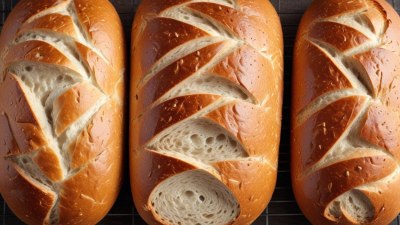Why Cold Weather Makes You Suddenly Need Three Kinds of Bread
Explore the surprising connection between cold weather and our craving for different types of bread.

This image was created with the assistance of Freepik
The onset of cold weather often brings about a shift in our cravings and desires for certain types of food. One surprising phenomenon many experience is the sudden urge for not one, but three distinct kinds of bread. This article delves into the psychological, physiological, and environmental factors that contribute to this interesting trend.
The Psychological Aspect of Cravings
When temperatures drop, our bodies enter a state where they seek warmth and comfort. Foods that are rich in carbohydrates, such as bread, are often associated with comfort eating. The winter months can be harsh, and our subconscious minds trigger cravings that lead us to seek warmth not just from our clothing and heating systems, but also from our meals. The understanding that food can evoke feelings of coziness is particularly evident when it comes to bread. It’s soft, warm, and satisfying, making it the culinary embodiment of comfort.
The Role of Carbohydrates
From a nutritional standpoint, carbohydrates play a crucial role in our diets, especially during the colder months. When we consume bread, our bodies break down these carbohydrates into glucose, which serves as an important source of energy. Cold weather can cause our metabolism to speed up slightly as our bodies work to maintain optimal body temperature. As a result, we may find ourselves craving additional energy sources to keep warm. This is where our drive for various kinds of bread comes into play. The three types of bread—white, whole grain, and sourdough—each fulfill different aspects of this craving.
White Bread: A Classic Comfort
White bread often represents the simplest form of comfort food. It’s soft, fluffy, and has a mild taste that pairs well with an array of toppings, from creamy butter to hearty soups. In colder months, many find that simple meals become more appealing, and white bread serves as the perfect foundation for a variety of warm dishes. It also evokes memories of childhood, home-cooked meals, and gatherings, which amplify its comfort factor during chilly days.
Whole Grain Bread: Nutritional Value
While white bread is comforting, whole grain bread brings with it a host of health benefits. As consumers become more health-conscious, the desire for whole grain options increases, especially when the body craves sustained energy. Whole grain bread is rich in fiber, vitamins, and minerals. The dense texture and nutty flavor provide a contrasting experience to the airy softness of white bread, appealing to those who seek something hearty and fulfilling. In cold weather, whole grain bread becomes particularly desirable as it offers more nutrition and satiety, keeping us energized during those winter months.
Sourdough: The Artisan Choice
Sourdough bread has seen a rise in popularity, and there's a good reason for that. The process of fermenting the dough not only gives it a unique flavor but also increases its digestibility. The tangy taste, coupled with a chewy texture, makes sourdough distinct and enjoyable. Furthermore, it pairs exceptionally well with winter dishes—think of a warm bowl of chili or a hearty stew. When temperatures drop, the artisanal appeal of sourdough can be particularly tantalizing, and many consumers prefer to embrace the DIY aspect. Baking sourdough at home becomes not only a fun project but a meaningful way to enjoy the winter season. This bread’s texture and flavor can create warm associations as it fills kitchens with delightful aromas.
The Influence of the Environment
Weather conditions significantly impact our eating habits. As snow falls and temperatures plummet, our mindset shifts toward seeking comfort in what we consume. As the days grow shorter and nights become longer, the desire for cozy, warm foods increases. Many turns to their kitchens, passionate about cooking and baking. The crisp aroma of freshly baked bread wafting through a home can evoke a sense of happiness and contentment. Bread plays a comforting role, providing warmth and sustenance during the colder months. The act of baking itself can feel therapeutic, acting as a nurturing process that not only addresses hunger but also satiates a longing for warmth.
Cultural Significance of Bread
Throughout history, bread has held cultural significance in many societies. In various cultures, the preparation and sharing of bread symbolize community, family, and hospitality. In cold weather, people often gravitate towards gatherings, and meals centered around bread are frequent. Whether it’s a loaf shared among family or artisan bread enjoyed with friends, the significance of bread within a social context amplifies. Cold weather encourages communal activities, and in many cases, meals become shared experiences where bread is central to the feast.
Emotional Connections to Bread
Food is deeply tied to emotions, and bread has its own share of nostalgic value. For many, it can be linked to memories of family dinners, holidays, or celebrations, especially in winter when people gather around the table to enjoy comforting foods. The presence of different types of bread can invoke various memories, triggering positive emotions that enhance our experience. Cold weather can exaggerate these feelings as people seek solace in familiarity and warmth.
Experimenting with Bread Recipes
Embracing the winter season can also pave the way for culinary experimentation. As cravings for bread emerge, individuals may find themselves inspired to try out new recipes or variations. Baking at home allows for a personal touch in creating the perfect loaf, whether that’s with seeded whole grain, rustic sourdough, or soft white bread. During cold months, people often feel a desire to engage in creative kitchen endeavors, leading to diverse interpretations of different types of bread. As they explore various techniques like incorporating herbs, spices, or even cheeses, bakers find joy in the tactile process, further increasing their attachment to bread.
The Role of Temperature on Baking
Ironically, as temperatures drop outside, the kitchen can become a warm haven filled with the comforting act of baking bread. The warmth of the oven and the inviting aroma of bread baking creates a cozy atmosphere that invites us to stay indoors. Baking bread creates a paradox where cold weather encourages indoor warmth and activity simultaneously, with the rise of bread providing a satisfying sensation as it approaches perfection in the oven. It becomes a ritual for many families to gather around the kitchen as bread rises, creating connections and shared warmth.
In summary, as the cold weather envelops us, our cravings for different types of bread heighten in tandem with our need for comfort, warmth, and nutrition. The psychological and physiological reasons for wanting white, whole grain, and sourdough bread reveal how deeply interconnected our seasonal cravings are with our overall well-being. Additionally, cultural roots, emotional links, and the fun of experimentation in baking further justify the fascinating need for these three types of bread. Thus, in winter, we aren't just satisfying hunger; we are feeding our souls, creating warmth, forging connections, and nurturing ourselves as we embrace the beauty of bread amidst the chill of the season.











